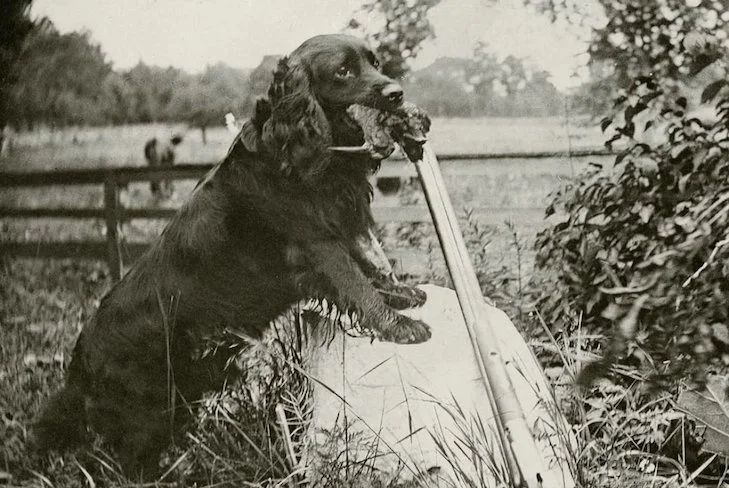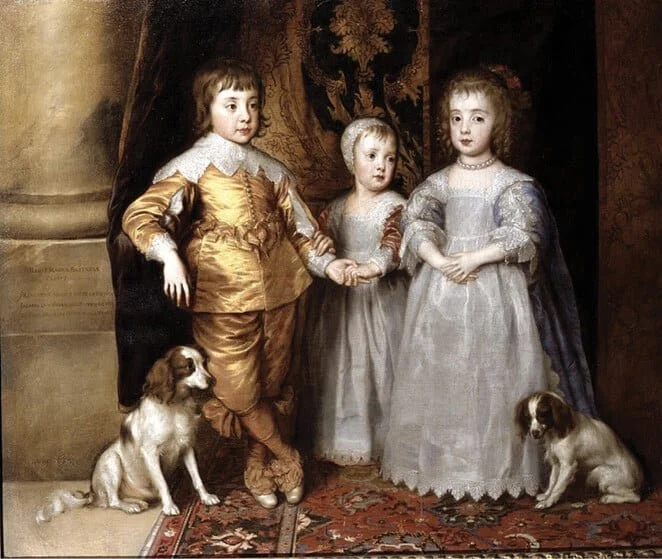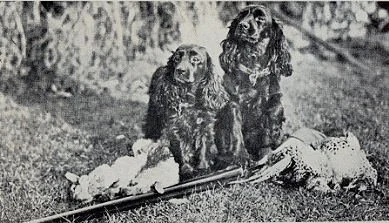The History of Spaniels
Spaniels, renowned for their gentle demeanor and exceptional hunting abilities, occupy a distinguished place in the annals of canine history.
Their narrative is a testament to the enduring relationship between humans and dogs, tracing back centuries to their origins as esteemed companions of European royalty.
Ancient Roots: Spaniels in the Early Days
The precise origins of spaniels remain a subject of scholarly debate, with various theories positing different geographical locations for their emergence. While some conjecture that spaniels originated in Spain, as suggested by their name, others propose ancient Greece or Rome as potential birthplaces. Regardless of their exact origin, it is evident that spaniels were selectively bred for their hunting prowess, captivating the attention of aristocrats across Europe for their exceptional skills in flushing out game birds.
In these early days, spaniels showcased the traits that would later define the breed: keen senses, intelligence, and boundless energy. Their ability to track game and retrieve downed prey made them invaluable allies to hunters, allowing humans to augment their hunting capabilities and secure vital sources of food.
Spaniels played a crucial role in the daily lives of ancient communities, assisting in the pursuit of various game species, including birds, rabbits, and small mammals. Their versatility and adaptability enabled them to thrive in diverse environments, from dense forests to open plains, where they would tirelessly work alongside hunters in the pursuit of quarry.
While specific breeds had not yet been established, the progenitors of spaniels laid the groundwork for the development of distinct varieties over time. Through centuries of selective breeding and natural selection, spaniels would evolve into the diverse range of breeds we know today, each with its own unique traits and characteristics.
Medieval Marvels: The Emergence of Distinct Breeds
References to "land spaniels" and similar terms began to appear in medieval literature and artwork, reflecting the growing recognition of spaniels as valuable hunting partners.
Their innate abilities, including a keen sense of smell and agility, made them indispensable assets in the pursuit of game birds such as pheasants and partridges. Depictions of spaniels in medieval artwork alongside noble hunters underscore their esteemed status within feudal society, serving as symbols of prestige and refinement.
During this time, spaniels were highly prized for their ability to work in varied terrains and conditions. Whether navigating dense forests, traversing open fields, or braving marshy wetlands, these adaptable dogs proved themselves invaluable to hunters and falconers seeking game birds and small mammals.
While medieval spaniels lacked the standardized breeds we recognize today, they exhibited common traits that would later define the breed. These included a keen sense of smell, intelligence, agility, and an innate instinct for flushing out game and retrieving downed prey.
Medieval nobility and aristocracy were particularly fond of spaniels, valuing them not only for their hunting abilities but also for their companionship and loyalty. Paintings and manuscripts from this period depict spaniels in various hunting scenes, showcasing their indispensable role in medieval society.
The emergence of distinct spaniel breeds would come later, as selective breeding and refinement efforts gained momentum in subsequent centuries. However, the medieval era laid the foundation for the development of these breeds, with spaniels already recognized for their exceptional hunting prowess and unwavering dedication to their human companions.
As the centuries progressed, spaniels underwent selective breeding to enhance specific traits conducive to various hunting environments and game preferences. This led to the emergence of distinct spaniel breeds, each characterized by unique physical attributes and hunting capabilities. For instance, the English Springer Spaniel distinguished itself with its aptitude for "springing" into action to flush out game from dense cover, while the Cocker Spaniel earned acclaim for its proficiency in hunting woodcock and other upland game birds.
Spaniels in the Courts of Europe
The Renaissance period witnessed the ascent of spaniels to a position of unprecedented prominence in European courts, where they became beloved companions to royalty and aristocracy. This era marked a significant shift in the perception of spaniels, as they transitioned from humble hunting partners to esteemed symbols of wealth, refinement, and prestige.
Spaniels found favor among European monarchs and nobility for their elegant demeanor, affectionate nature, and unwavering loyalty. They were often depicted in portraits and tapestries alongside their aristocratic owners, serving as visual representations of status and sophistication.
One of the most notable examples of royal favor bestowed upon spaniels is found in the court of King Charles II of England. King Charles II was famously devoted to his spaniels, particularly those of the toy variety that would later bear his name: the Cavalier King Charles Spaniel. These small, affectionate dogs were constant companions to the king, accompanying him everywhere from the royal chambers to the hunting fields.
In addition to their roles as cherished companions, spaniels were valued for their practical contributions to court life. They were often employed in the pursuit of small game, such as rabbits and birds, providing entertainment and sport for the royal household. Their agility, intelligence, and keen senses made them ideal hunting partners, earning them the admiration and appreciation of their noble patrons.
Spaniels also played a role in courtly etiquette and ceremony, with trained dogs performing tricks and entertaining guests at lavish banquets and gatherings. Their presence added an element of charm and whimsy to formal occasions, further endearing them to their royal hosts and guests.
As symbols of wealth and status, spaniels became highly sought after among the European elite, leading to the development of specialized breeding programs to produce dogs of exceptional quality and lineage. These efforts resulted in the refinement of spaniel breeds and the establishment of breed standards that continue to shape the breed to this day.
The Renaissance Era:
The Renaissance period witnessed a flourishing of hunting culture, providing an ideal milieu for spaniels to showcase their talents. Advancements in hunting techniques and firearms elevated the importance of these canine companions, who played integral roles in flushing out and retrieving game for their human counterparts.
The 18th and 19th centuries marked a period of profound change in the world of sports and leisure, and spaniels played a central role in this transformative era. Known for their agility, stamina, and keen hunting instincts, spaniels emerged as indispensable partners to sportsmen and gamekeepers, earning widespread acclaim for their versatility and prowess in the field.
Organized field trials and competitions emerged as a means of testing and showcasing the abilities of spaniels and other sporting dogs. These events not only provided entertainment for spectators but also served as a venue for breeders and enthusiasts to assess breeding stock and promote the development of superior working lines.
One of the most influential figures in the history of spaniels during this period was the 4th Duke of Newcastle, who authored the seminal work "The Sportsman's Dictionary" in 1725. In this comprehensive treatise on hunting and field sports, the Duke extolled the virtues of spaniels as indispensable companions to sportsmen, emphasizing their intelligence, agility, and unwavering dedication to their human partners.
Transition to Companions
The Duke's advocacy for spaniels helped to elevate their status in the world of field sports, inspiring a new generation of enthusiasts to appreciate and cultivate the talents of these remarkable dogs. Spaniels became increasingly sought after for their exceptional hunting abilities, with breeders striving to produce dogs of superior quality and pedigree.
The Industrial Revolution heralded significant societal changes that impacted the role of spaniels, marking a transition from working dogs to cherished companions within the home. As traditional hunting estates declined and urbanization accelerated, spaniels found a new purpose as devoted household pets. Their affectionate nature and adaptability endeared them to families of all backgrounds, solidifying their status as beloved companions.
The development of specialized spaniel breeds, such as the English Springer Spaniel and the Cocker Spaniel, further fueled the popularity of spaniels as sporting dogs. Each breed was carefully bred and refined to excel in specific aspects of hunting, whether flushing game from dense cover or retrieving birds from water.
The Sporting Spaniel Club, founded in 1899, played a pivotal role in promoting the interests of spaniels and their owners, organizing field trials, and advocating for responsible breeding practices. The club's efforts helped to raise awareness of spaniels' capabilities and solidify their reputation as top-tier sporting dogs.
Breed Development:
The evolution of spaniels from versatile hunting companions to distinct and standardized breeds is a testament to centuries of careful breeding, refinement, and dedication by enthusiasts and breeders. This process of breed development played a crucial role in shaping the characteristics and standards that define each variety of spaniel today.
While some retain their hunting instincts and excel in field trials, many are valued primarily as loyal companions and therapy dogs. Breed standards have evolved to prioritize not only physical conformation but also temperament, ensuring that spaniels remain exemplary companions capable of enriching the lives of their human counterparts.
The development of specialized spaniel breeds, such as the English Springer Spaniel, the Cocker Spaniel, and the Field Spaniel, further contributed to the diversification of the breed. Each variety was bred and refined to excel in specific aspects of hunting, whether flushing game from dense cover, retrieving birds from water, or working in upland fields.
The establishment of kennel clubs, such as The Kennel Club in England and the American Kennel Club in the United States, provided a platform for breeders and enthusiasts to showcase their dogs and promote responsible breeding practices. Dog shows and field trials became popular venues for evaluating the abilities and conformation of spaniels, further driving the refinement and standardization of the breed.
Spaniels Today
One of the most enduring qualities of spaniels is their affectionate and sociable nature, making them ideal companions for individuals and families. Whether curled up on the couch or frolicking in the backyard, spaniels thrive on human interaction and thrive in environments where they are valued as members of the family.
Spaniels are renowned for their gentle disposition and adaptability, making them well-suited to various living situations, from bustling urban apartments to sprawling suburban estates. Their adaptable nature enables them to thrive in diverse environments, provided they receive adequate exercise, mental stimulation, and companionship.
While spaniels retain their hunting instincts and athletism, they have also become valued for their role as therapy and emotional support animals.
In addition to their roles as beloved companions, spaniels continue to participate in a variety of activities and events that showcase their talents and abilities. From participating in dog shows and agility competitions to volunteering as therapy dogs in hospitals and nursing homes, spaniels contribute to their communities in meaningful and impactful ways.






